Mirella Sichirollo Patzer's Blog, page 51
September 30, 2011
16th - 17th Century Women's Fashions
A beautiful video depicting original women's fashions of the 16th and 17th century. I discovered it while researching one of my current works in progress set in 17th century Italy. With the exception of the iron corset, we are fortunate that these delicate garments have survived for so many centuries. Enjoy
I LOVE COMMENTS










I LOVE COMMENTS










Published on September 30, 2011 16:22
September 25, 2011
In Pursuit: The Katherine Mansfield Story by Joanna Fitzpatrick
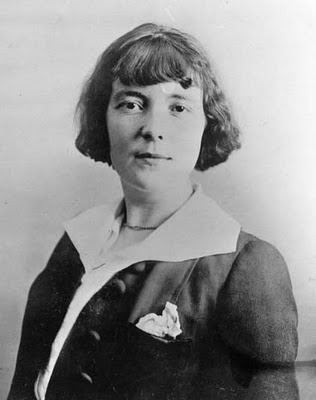 Katherine Mansfield is New Zealand's most beloved author. During her fascinating, tragic life, her path became intertwined with D.H. Lawrence and the fascinating Virginia Woolf.
Katherine Mansfield is New Zealand's most beloved author. During her fascinating, tragic life, her path became intertwined with D.H. Lawrence and the fascinating Virginia Woolf. Unfortunately, despite her literary brilliance, Mansfield's life was plagued with isolation, sickness, envy, spite, and estrangement. Her many hardships transferred themselves into her writing where she excelled at depicting bitterness, and marital problems with her middle-class characters.
Katherine Mansfield was born into an affluent banking family. She spent her early years in Karori, a village a few miles from Wellington, New Zealand where she spent several happy and tranquil years. As she became school-aged, she attended a private girl's school and later was sent to London to attend Queen's College. There she studied French, German and music, and began writing prose and poems and took a liking to the exciting lifestyle.
She returned to Wellington, defiant and troubled even though she led a comfortable and socially rich life. But she found her parent's watchfulness too overbearing Wellington hopelessly boring and backwards. Bored, she rebelled and spent her days writing out her complaints and having affairs with both men and women.
She took a wild adventure into remote Urewera country in the middle of the North Island.
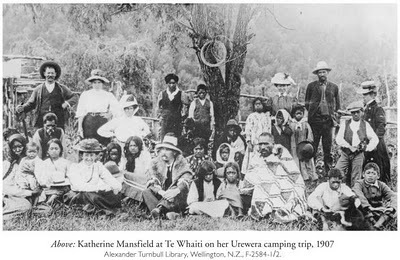
Bored and unhappy, she conspired with her lifelong friend Ida Baker who persuaded Mansfield's father to allow Katherine to move back to England, with an allowance of £100 a year. There she devoted herself to writing and never returned to New Zealand again.
Once back in England, she became sexually reckless and promiscuous. Almost immediately, she fell in love with Garnet Trowell, a young violinist whose father had once taught her the cello in Wellington, but their love did not last. When it ended, she rebounded and married G.C. Bowden, but left him the day after their wedding. She returned to Garnet and travelled with his opera company. Soon she became pregnant, and shortly thereafter, left him and ran to her friend, Ida Baker, a school chum. Katherine's mother suspected their relationship was not a "healthy" one and swept her pregnant daughter to Bavaria for a water cure to heal her from whatever ailed her.
Katherine gave birth to a stillborn child and remained in Germany several more months. She met a Polish writer and swindler named Florian Sobienowski. On her return to London, Mansfield became ill with an untreated sexually transmitted disease she contracted from Floryan Sobieniowski; a condition which contributed to her weak health for the rest of her life. Sobieniowski would later blackmail her with letters she wrote during this time.
Katherine found herself in new literary circles and met the clever and gifted John Middleton Murray who came from the lower-middle-class. Soon, she discovered she had tuberculosis. Within weeks of meeting, Mansfield and Murry became lovers, moved in together, and both began to write voraciously.
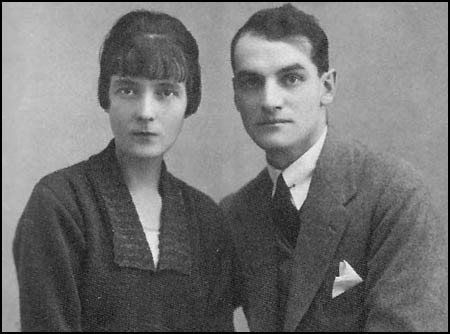 Mansfield and Murry
Mansfield and MurryThey became friends with author, D.H. Lawrence and Frieda Weekley, acting as witnesses at their wedding, but their relationship with the couple became troubled and intense.
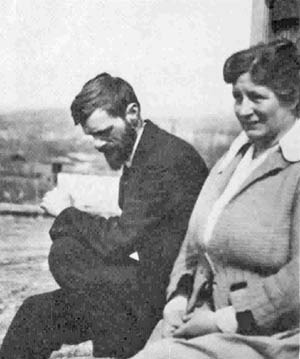 Lawrence and Frieda
Lawrence and FriedaUpon learning that Murry had an affair with the Princess Bibesco, Mansfield objected not to the affair but to the woman's letters to her husband: "I am afraid you must stop writing these love letters to my husband while he and I live together. It is one of the things which is not done in our world."
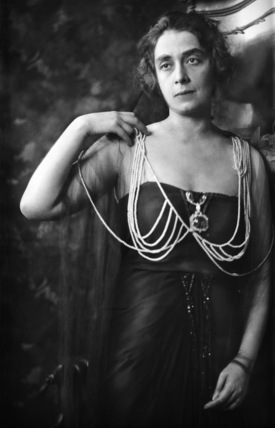 Princess Bibesco
Princess BibescoKatherine and John Murry tried to move to Paris, but Murry was forced into bankruptcy when his journals failed. During this difficult time, they were forced to move often and lived on paltry earnings.
Katherine Mansfield had a close friendship with author, Virginia Woolf that lasted many years.
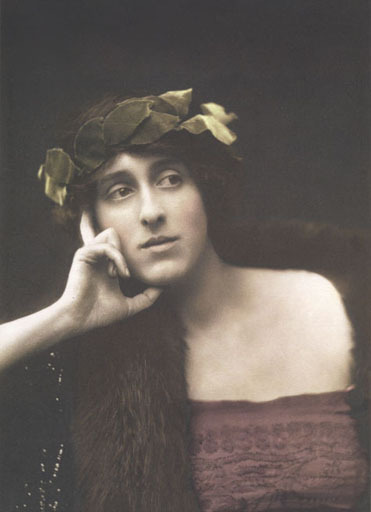
Katherine spent her last years travelling between southern France and Switzerland, being treated for her tuberculosis. In one treatment, she laid for several hours a day on a platform suspended over a cow manger in order to breathe the odours. But the treatment, like many others, failed. Desperately alone and sad, she wrote. At times, her illness made her malicious and cold.
Katherine Mansfield died of a pulmonary hemorrhage on January 9, 1923, in Gurdjieff Institute, near Fontainebleau, France. Her last words were: "I love the rain. I want the feeling of it on my face."
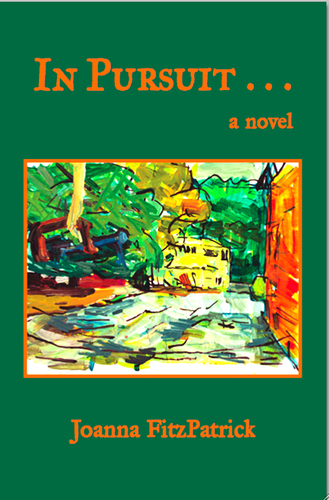
Back Cover Blurb:
"In Pursuit . . ." reinvents the life of Katherine Mansfield (1988-1923), the modernist writer who revolutionized the short story, created the only writing Virginia Woolf was ever jealous of, and was consumed by tuberculosis at thirty-four. Intertwined into the story are Katherine's letter and journal writings that reveal her volatile relationships with her husband, her caregiver Ida, and her extraordinary passion for life as she fights against a disease that saps her energy and steals her time to write. The story begins in London where Mansfield has married her long-time lover John Middleton Murry. Soon after, on her thirtieth birthday, she is diagnosed with tuberculosis and told she has a few years to live if she stops writing, moves to a sanatorium, and promises to live a quiet, passive life. Too young for such a prognosis she attempts a home cure that fails. Then, a wandering consumptive with a fierce grip on life and her writing tools, she travels from London to Paris, to the Riviera and to the Alps in pursuit of a cure, not only for herself, but through her work, perhaps, for others. "In Pursuit . . . The Katherine Mansfield Story Retold" is an absorbing tale of desire, impermanence, and atonement. A haunting exploration of one woman's powerful determination to live a full and challenging life in spite of the limitations forced upon her by illness.
Thoroughly researched, author Joanna FitzPatrick has recreated the life of Katherine Mansfield with all her troubles, failures, successes, and wildness. She poignantly depicts Mansfield's brilliant career as a beloved author as she struggles to overcome a threatening illness that impeded her writing and tore her marriage apart while fueling her depedence on loyal friends and loves.
Reading this book introduced me to the life and works of Katherine Mansfield and encouraged me to search out the work of this famous, most brilliant author.
Joanna FitzPatrick has penned a thorough biography depicting the life of the passionate Katherine Mansfield.
I LOVE COMMENTS










Published on September 25, 2011 13:05
September 23, 2011
Clare Scifi (Saint Clare of Assisi)
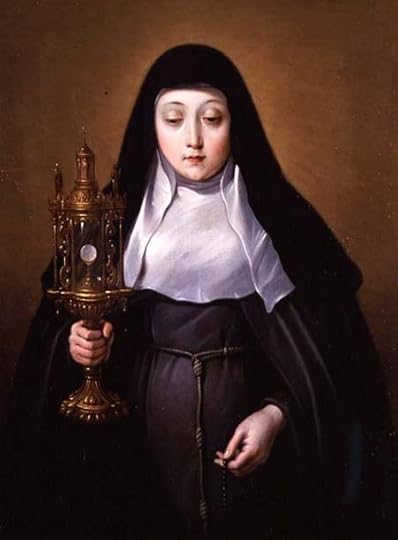 Clare of Assisi16 July 1194 - 11 August, 1253
Clare of Assisi16 July 1194 - 11 August, 1253My name is Clare and I was born the eldest daughter of a noble family in Assisi Italy in the year 1193. My family owned a large palazzo in Assisi and a castle on the slope of Mount Subasio. My father was Favorino Scifi, Count of Sasso-Rosso, a wealthy man descended from an ancient Roman family. My mother was Countess Blessed Orsolana who belonged to a noble family of Fiumi and was known for her fervor and piety.
From childhood, I was devoted to prayer. As I grew into girlhood, my distaste for the world and my yearning for a more spiritual life increased. I was 18 years of age when a man known as Francis of Assisi came to preach in the church of San Giorgio at Assisi. They called him the Poverello, or the poor man, and his humble but powerful words kindled a flame in my heart. After the service, I sought him out secretly and begged him to help me so that I too might live religiously. Immediately, he recognized that God had chosen my soul and he told me that I was destined for great things. He foresaw that in the future, many would follow my example. He promised to assist me. From that moment on, we became close friends - he as my wise tutor, and I as his eager student. Our friendship was to endure our entire lives.
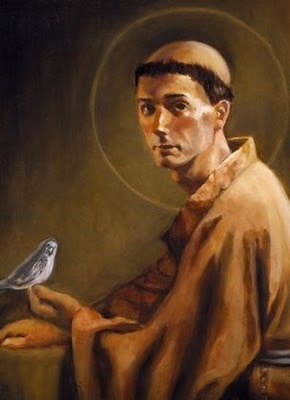 Francis of Assisi(il Poverello)
Francis of Assisi(il Poverello)On Palm Sunday on March 20th in the year 1212, arrayed in all my finery, I attended Mass. When others pressed forward to the altar-rail to receive their branches of palm, I remained in my place, rapt in a dream. All eyes fell upon me as the bishop noticed me and came to place a palm in my hand. Stunned, I glanced down at the branch in my hands and knew it was a sign from God. That was the last time the world beheld me.
That night, encouraged by Francis of Assisi, while everyone slept, I secretly left my palazzo. Accompanied by my aunt Bianca and another companion, we made our way to the modest chapel of the Porziuncula where Francis and his disciples met me with lights in their hands.
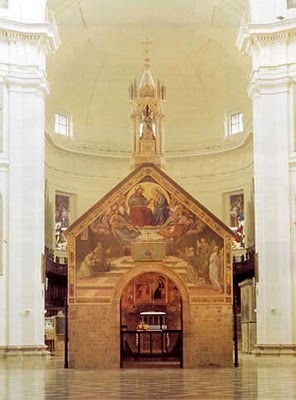
There, I laid aside my rich garments. Francis cut off my hair and I donned a rough tunic and thick veil. In this way, I vowed to serve Jesus Christ. Francis then placed me with the Benedictine nuns of San Paolo, near Bastia.
When my father learned of my secret flight, he became furious, for he had expected me to make a splendid marriage. He arrived in San Paolo and tried to drag me away by force. But I held my own with strength and firmness until my father was finally obliged to leave me in peace. A few days later, Francis, in order to secure for me the solitude I desired, transferred me to Sant'Angelo in Panzo, another monastery of the Benedictine nuns on the flanks of Subasio. Here some sixteen days after my own flight, my sister, Agnes joined me, whom I was instrumental in delivering from the persecution of our infuriated relatives.
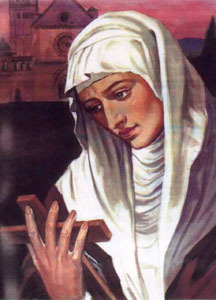
Agnes of Assisi
My sister and I remained with the nuns at Sant'Angelo until we, and other women fugitives from the world, were established by Francis into a rude dwelling adjoining the poor chapel of San Damiano, situated outside the town which he had rebuilt with his own hands.
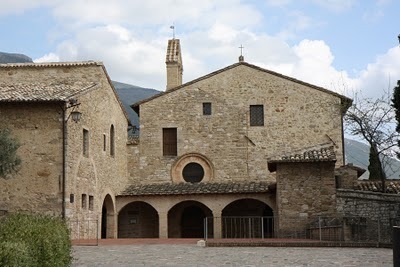
San Damiano
Thus was founded the first community of the Order of Poor Ladies, or Poor Clares. Like the Franciscans, we followed the absolute rule of poverty, a rule dear to the heart of Francis. Owning nothing, we were to depend entirely upon what the friars could beg for on our behalf. Although even the pope tried to dissuade us from practicing such a harsh rule, I resisted, until finally I earned the pope's admiration and he permitted us to retain our strict poverty.
In 1215, much against my will, Francis made me the superior at San Damiano. There I ruled as abbess for forty years. In all that time, I never once went beyond the boundaries of San Damiano. The people came to know me as a living example of poverty, humiliation, and mortification and I frequently engaged in manual labour. Our community at San Damiano became known for every virtue. After my father's death, my younger sister Beatrix, my mother Ortolana, and my faithful aunt Bianca followed Agnes and I into the order.
Although I was strong and determined, I was a woman of gentle spirit. I loved music and the brilliance of a well-spoken sermon. In all things, I strived to be humble and merciful. Many praised me for my charm, optimism, and chivalry. Every day, I prayed. I would rise late at night to lovingly check on my sisters and tuck them in if they had kicked off their blankets. Slowly, wherever Franciscan monasteries were built, so did one for the Poor Clares. Soon, our monastic order spread to all corners of Europe.
But my most important role was to aid and encourage Francis. It was to me he turned when in doubt, and it was I who urged him to continue his mission to the people at a time when he thought his vocation lay rather in a life of contemplation. When he became blind and ill, Francis came for the last time to visit San Damiano. I had a little wattle hut built for him in an olive grove close to the monastery and here he spent his last days. After his death, the procession which accompanied his remains stopped so that I and the sisters might venerate him. Francis would always live, and my loyalty never swerved from his ideals, which I clung to with jealous care for the rest of my life.
In 1234, the army of Frederic II was devastating the valley of Spoleto. The soldiers scaled the walls of San Damiano by night, spreading terror among the community. I rose calmly from my sick bed, and taking the ciborium from the little chapel adjoining my cell, faced the invaders at an open window against which they had already placed a ladder. As I raised the item high, the soldiers who were about to enter the monastery fell backward as if dazzled, and the others who were ready to follow them took flight. It is with reference to this incident that I have since represented in art bearing a ciborium.
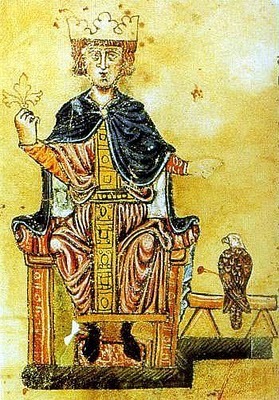
Frederic II
Later, an even larger force returned to storm Assisi. I gathered the nuns about me and knelt with them in earnest prayer that the town might be spared. A furious storm arose, scattering the tents of the soldiers in every direction, and causing such a panic that they again took refuge in flight. The people of Assisi attributed their deliverance to my act of intercession.
Although I had long been enshrined in the hearts of the people, their love for me became more apparent as, wasted by illness and austerities, I drew towards my own end. Brave and cheerful to the last, in spite of my long and painful infirmities, I permitted myself to be raised in bed and I spun the finest thread for the purpose of having it woven into the most delicate material. From this cloth, I made more than one hundred corporals, square white linen cloths smaller than the breadth of an altar, upon which chalices were to be placed during the celebration of Mass. Enclosing them in a silken burse, I ordered them to be given to the churches surrounding the plains and mountains of Assisi. When I became too ill to attend Mass, an image of the service would appear on the wall of my cell. Because of this miracle, I was to one day become the patron saint of television.
When I felt the day of my death approaching, I gathered my sorrowing nuns and charged them with preserving the observance of poverty. The pope came from Perugia to visit me and my sister Agnes returned from Florence to console me at my deathbed. After receiving last rites, before dawn on 11 August, 1253, I passed peacefully away with touching simplicity.
But my story does not end here. The Clares wanted to retain my body among them at San Damiano, but officials of Assisi interfered and wanted my remains to reside within the town, arguing I had saved the town from destruction on two occasions. Because these miracles were talked of far and wide, it was not safe, the officials urged, to leave my body in a lonely spot without the walls; it was only right, too, that I should have a church in Assisi built in my honour. Amid all this bickering, my remains were placed in the chapel of San Giorgio, where Francis's preaching had first touched my young heart, and where his own body had been interred.
Two years after my death, on the 26th day of September, 1255, I was canonized a saint. Not long afterwards the church of Santa Chiara (Saint Clare) was begun. Upon its completion, my remains were transferred there, buried deep down in the earth under the high altar, far out of sight and reach. Over the years, I was forgotten and my remains remained hidden for 6 centuries, lost to the world.
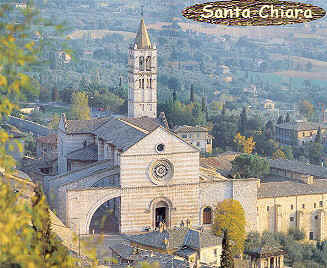
After much searching, however, my long lost tomb was found on September 23rd, 1850, to the great joy of the people of Assisi. My coffin was unearthed and opened. My flesh and clothing had been reduced to dust, but my skeleton was in a perfect state of preservation. Finally, on the 29th of September, 1872, my bones were transferred, with much pomp, to the shrine, in the crypt at Santa Chiara, where it was originally erected to receive them centuries earlier, and where they may now be seen enclosed in a representation of my body.
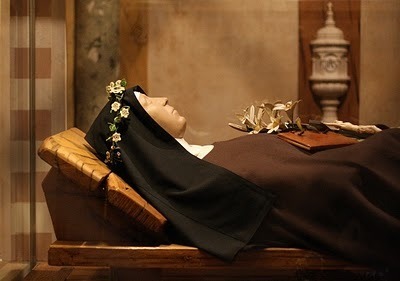
My feast day is celebrated on August 11. Because my name, Clare means clarity, brightness, and brilliance, I was to become the patron saint of eyes and eyesight in addition to the patron saint of television.









Published on September 23, 2011 17:07
September 16, 2011
Love Child by Sheila Kohler
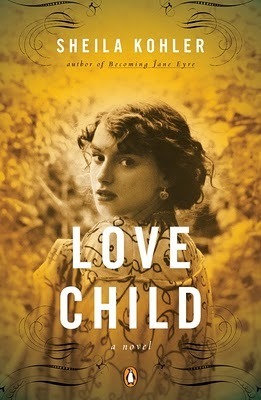 The compelling story of a forbidden marriage, a baby lost, and a love triangle gone horribly wrong, Love Child centers on Bill, a South African woman whose life has been defined by the apartheid-era, class-riven society in which she lives. Under pressure to make her will, Bill is forced to think about the momentous events and decisions that have made her an extremely wealthy if somewhat disillusioned woman. To whom should she leave her fortune? As Bill relives her past, we learn that this is a simple question with a complicated answer. In elegant, sensual, and nuanced prose, Kohler skillfully explores the space between our dreams and our reality, between our hopes and our disappointments.
The compelling story of a forbidden marriage, a baby lost, and a love triangle gone horribly wrong, Love Child centers on Bill, a South African woman whose life has been defined by the apartheid-era, class-riven society in which she lives. Under pressure to make her will, Bill is forced to think about the momentous events and decisions that have made her an extremely wealthy if somewhat disillusioned woman. To whom should she leave her fortune? As Bill relives her past, we learn that this is a simple question with a complicated answer. In elegant, sensual, and nuanced prose, Kohler skillfully explores the space between our dreams and our reality, between our hopes and our disappointments. Love Child is a novel about a woman of wealth and class set during the time of apartheid in South Africa. In 1956, Bill is a lonely but fabulously rich widow who is under pressure by her family accountant/attorney to write her will in favour of her two well-educated teenage sons.
Through flashbacks to 1925, Bill examines her past with all its dark secrets and lies. Not even her family knows of her life and her secret shame and story of a lost love she has carried with her for thirty years. When Bill meets Isaac, a man of lower class, at her father's diamond business, a passionate love blossoms and soon the couple elope. After consummating the marriage, they arrive on the doorstep of Bill's three spinster aunts who conspire with her father to separate the young lovers. Cloistered in the home of her aunts, Bill is forced to endure their solutions to her unapproved of marriage and its consequences.
Author Sheila Kohler writes a deep and intellectual story of loneliness and loss, atonement and hope. She delves deeply into the social values of a society plagued by racism and class structure. This is a novel where readers must look beyond the written words and seek to understand the story's deeper meaning. I enjoyed this story about a forbidden marriage, a baby stolen away, and a love triangle torn asunder. It left me feeling a little haunted – a deeply complex book that portrays the fate of many an unwed mother in decades not so long ago.
I LOVE COMMENTS










Published on September 16, 2011 14:07
September 15, 2011
Lucille Ball - Candy Factory Clip
Published on September 15, 2011 20:41
September 10, 2011
The Victorian Guide to Women
Published on September 10, 2011 19:43
Covenant with the Vampire by Jeanne Kalogridis
 Wow! What a novel! Simply unbelievable! This is a novel that left me breathless, turning the pages until long into the night. It is the first book of a trilogy. Without doubt, this trilogy is the most beautifully written vampire novels ever written. Through beautiful and profound prose, and in diary format, Jeanne Kalogridis reveals the story of Arkady Tsepesh and how he and his pregnant wife return to Transyvannia after the death of his father. The firstborn heir is expected to be the main council or aid to patriarch/uncle Vlad Dracula. Strange, evil, horrifying things begin to occur immediately, setting the grim, tense mood that only grows more intense until the end of the book.
Wow! What a novel! Simply unbelievable! This is a novel that left me breathless, turning the pages until long into the night. It is the first book of a trilogy. Without doubt, this trilogy is the most beautifully written vampire novels ever written. Through beautiful and profound prose, and in diary format, Jeanne Kalogridis reveals the story of Arkady Tsepesh and how he and his pregnant wife return to Transyvannia after the death of his father. The firstborn heir is expected to be the main council or aid to patriarch/uncle Vlad Dracula. Strange, evil, horrifying things begin to occur immediately, setting the grim, tense mood that only grows more intense until the end of the book. Covenenant with the Vampire is intended to be a prelude to Bram Stoker's Dracula. She writes in the same style as the classic author, but her prose far supercedes that of SToker (Sorry Bram - but with Jeanne you've met your match!) If you like a book filled with the odd and unusual that will shock and horrify you with its evil darkness as innocents try to overcome the evil Vlad, then this is a must, must read. A roller coaster ride that sends one chill up your spin just as another begins! Get it - I really mean it. The best vampire stories currently available bar none!
I LOVE COMMENTS










Published on September 10, 2011 08:33
September 9, 2011
Madame de Sévigné Quote
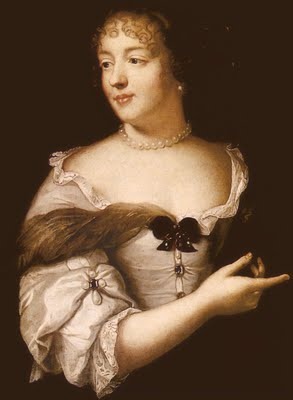
One loves so much to talk of one's self that one never tires of a tête-à-tête with a lover for years. That is the reason that a devotee likes to be with her confessor. It is for the pleasure of talking of one's self--even though
speaking evil.
Madame de Sévigné









Published on September 09, 2011 16:57
September 8, 2011
Heiress by Susan May Warren

Set in New York during the opulent world of the Gilded Age in the late eighteen hundreds, HEIRESS by Susan May Warren is the story of two sisters who have it all and find out that being an heiress has a very high price tag especially when it comes to love.
Author Susan May Warren has astounded us with another future bestseller in this first book of a new trilogy entitled the Daughters of Fortune. From the very first pages, I was enthralled with the passionate story that unfolded upon its pages.
The story is about the two very different daughters of August Price. First, there is Esme. Proud and headstrong, she wants nothing more than to follow in her father's footsteps and become a journalist and then heir to his newspaper empire. Jinx is the exact opposite and jealous of her elder sister and avidly desires to grace society's grandest ballrooms in search of a wealthy husband. Their mother, Phoebe, is determined to ensure both her daughters are married off to men of great means.
What follows is clever plot steeped in rebellion, transgression, betrayal, and passionate love. Filled with plenty of twists and turns, I was fascinated with the story and the trials of the two daughters whom fate separated, but later threw together in a fascinating, suspenseful ending. It is a story of opposites – from great wealth to the dregs of poverty, taking the reader from New York's ballrooms to the wilds of Montana. Although this is Christian historical fiction, there is little preaching. Rather, the author cleverly weaves subtle, but powerful lessons about love and value and family into the story. Most definitely I will read this books sequels. Highly recommended!
I LOVE COMMENTS










Published on September 08, 2011 13:11
September 7, 2011
Lady of the English by Elizabeth Chadwick
Book Review and Book GiveawayLady of the English by Elizabeth Chadwick
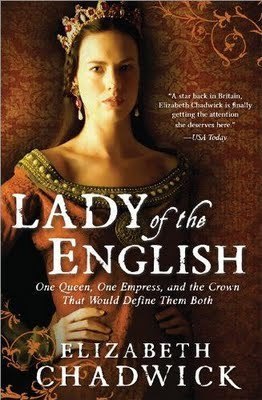
Back Cover Blurb
Two very different women are linked by destiny and the struggle for the English crown. Matilda, daughter of Henry I, is determined to win back her crown from Stephen, the usurper king. Adeliza, Henry's widowed queen and Matilda's stepmother, is now married to William D'Albini, a warrior of the opposition. Both women are strong and prepared to stand firm for what they know is right. But in a world where a man's word is law, how can Adeliza obey her husband while supporting Matilda, the rightful queen? And for Matilda pride comes before a fall ...What price for a crown? What does it cost to be 'Lady of the English'?
 Empress MatildaLady of the English(Maud)
Empress MatildaLady of the English(Maud)
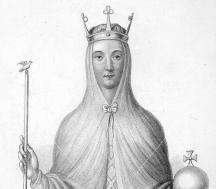 Adeliza of LouvainQueen of England
Adeliza of LouvainQueen of England
Matilda was one of two legitimate children of King Henry I of England. When her brother, William, died in the White Ship disaster, she became her father's sole heir. Her father made his noblemen swear their oath to accept Matilda as queen of England and duchess of Normandy after his death.
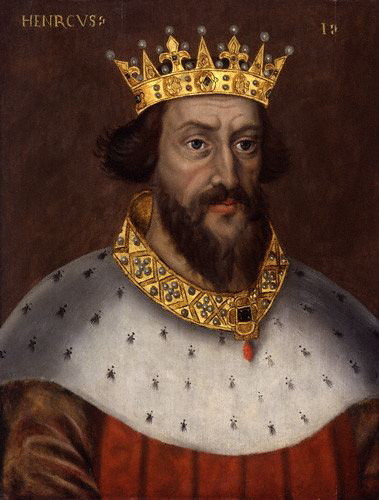 King Henry I of England
King Henry I of England
As a young woman, Matilda was sent to Germany as the bride of Henry V, Holy Roman Emperor. By all accounts, they had a happy but childless marriage.
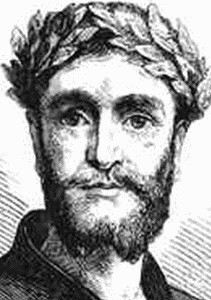 Henry VHoly Roman Emperor
Henry VHoly Roman Emperor
When Henry died in 1125, Matilda returned to England where her father forced her, now a dowager empress, to marry Geoffrey of Anjou, a lesser nobleman eleven years her senior. This new marriage brought her little happiness. From the start, it was fraught with abuse. She left him and ran back to England. But political need came into play. Through her father's intervention, and urged by step-mother Adeliza, Matilda reluctantly returned to Geoffrey. She bore him three sons, Henry (later King Henry II of England, Geoffrey (Count of Nantes) and William.
 Geoffrey of Anjou
Geoffrey of Anjou
Matilda's father, King Henry I of England, died in 1135. Forgetting the vow they made to crown Matilda as Queen of England, the nobles reneged and placed Stephen of Blois, her cousin on the throne.
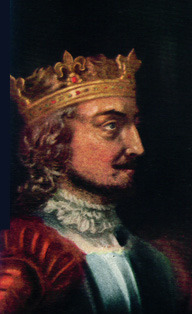 Stephen of Blois
Stephen of Blois
But Stephen did not prove a popular king. Several of his nobles turned on him. The nobles urged Matilda to come to England to be crowned. With the support of her uncle, King David of Scotland, and his army, Matilda attempted a return. Stephen was captured and taken prisoner at a battle at Lincoln.
No woman had ever ruled England or Normandy, especially Matilda who had a reputation for being arrogant, bad-tempered, and moody. Few people liked her. Nevertheless, she travelled to Winchester, and was proclaimed queen. It was then her difficult personality became evident. She refused to converse kindly with the people.
Stephen's wife visited her to beg for her husband's freedom in exchange for their exile across the sea and a promise to never interfere in her life again. Matilda refused and ordered the woman away, a decision she would come to regret.
Those loyal to Stephen, continued to fight for him. Their cause gained support as more and more people became disenchanted with their harsh, unkind queen. Even her husband would not come to England to help her. Surrounded by her enemies, she was forced to flee from Winchester, her supporters killed or captured. Disguised in a coffin perforated with holes so she could breath, Matilda made it to Gloucester and Oxford Castle. While one of her supporters crossed the sea to fetch her eldest son Henry who was ten years old, her castle was besieged by Stephen whom Matilda had earlier freed. His men surrounded the castle and prevented food and supplies from entering.
Determined to escape, she and three of her knights dressed themselves in white and in the dead of winter, escaped by climbing down the walls with ropes. Camouflaged against the snow, no one saw them. They crossed the ice-covered river on the ice, walked in the night, and arrived at Abingdon. On horseback, they rode to Wallingford, where Matilda greeted her young son, Henry.
An uneasy truce between Stephen and Matilda came to be. Matilda raised her son at Gloucester until her husband sent for him so he could see his eldest before he left on a crusade. Geoffrey died during this crusade.
Matilda no longer wanted to be queen. Her son, Henry, became king.
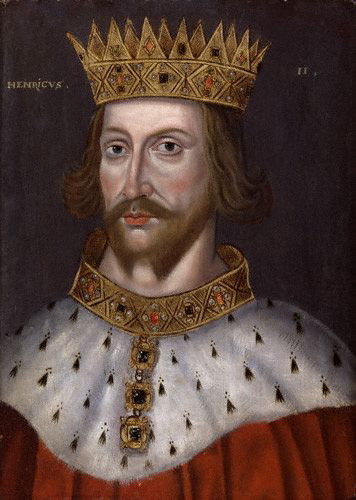 Henry IIKing of England
Henry IIKing of England
Matilda retired to a convent until she died at Rouen in France where she was buried. Her epitaph reads:
"Here lies the daughter, wife, and mother of Henry."
From start to finish, Lady of the English by Elizabeth Chadwick captured my interest. As with all of Elizabeth's novels, the story is vividly described with a depth of historical detail that is rarely matched by other novelists in the genre. She brings to life the story of a queen who was contrary, vitriolic, and verbally blunt. Despite the known rancorous personality of this fascinating queen, the author allows us to see her in several dimensions – a young bride, an abused wife, a political pawn. And it is this that allows us to admire her courage and strength in the face of an entire country that refused to fully accept her as their queen. A wonderful reprieve from all the Tudor novels that are saturating the market, I urge you to get this book for insight into this fascinating woman's life.
An Interview with Elizabeth Chadwick

Many thanks to the members of Historical Novel Review for inviting me to give this blog interview.I'm delighted to be here!
I'm very excited to have one of Britain's finest writers joining us here today. A warm welcome to Elizabeth Chadwick. Thank you for taking the time to allow us to get to know you better.
1. Can you tell us a little about your novel?
LADY OF THE ENGLISH is the story of Empress Matilda, daughter of King Henry I. She was so called because she had married the Emperor of Germany at the age of 12 and lived at the German court . When she was about 23, her husband died and her father summoned her back to his side, intending to make her heir to England and Normandy. A woman on the throne was not a popular choice in a male dominated society, and Matilda found herself forced into marrying a youth she hated because her father ordered it so. When her father died, Matilda's claim to the throne was pushed to one side by his barons, who elected her male cousin Stephen to the throne instead. The scene was set for war as Matilda set out to claim her rightful crown.
LADY OF THE ENGLISH is also the story of Matilda's stepmother Adeliza of Louvain. She was the same age as Matilda and had been married at a very young age to Matilda's father as his second wife. The women became good friends and allies. Adeliza married a baron of the opposition, and the story follows Adeliza's struggle to help Matilda and yet still be a good wife to her husband. It examines through the characters different aspects what it meant to be a woman in the 12th century.
2. What inspired you to write a novel about a woman in this period of history?
I have always written about the medieval period and both men and women in this timeframe. It's my home territory and my comfort zone. I have done detailed research into the period and I love bringing it to life for a modern audience. It's as simple as that. I am always inspired by the Middle Ages! Also the more I research, the more I realise how much we don't know about the period today, and how much we assume we know which is often very wrong. For example: At one end you have the view that women were powerless in the society of the time, and at the other end the view that actually they were very powerful and filled with the light of modern feminism. The truth is always tinted in shades of grey. They weren't powerless, but their power was measured in different ways to modern Western society. They had their fields of influence that waxed and waned with their role in society. The most powerful women were mothers of male children and widows who were able either to wield the reins behind-the-scenes, or take them in their own right. Daughters and young wives were perhaps the most powerless and had to bide their time.
3. What hardships did women face in this particular century and what lessons can today's woman learn from it?
I've covered this is in a small part in the above question. They didn't have independence as we know it, and had to work out how to get their own way by more subtle means, but it also meant they were more vulnerable. A man was permitted to beat his wife for example, and property laws frequently put women at a disadvantage. Other hardships, are still suffered by many women around the globe today. Famine, war, rudimentary and often ineffective healthcare were just a few of the hardships medieval women might face at some point in their lives. There was the absolute peril of childbirth to face time and again. Contraception was haphazard at least, and the belief system said that one should only lie with one's spouse for the intentions of procreation.
Without vaccination, without access to good paediatric care, only the strong survived and Medieval women often had to deal with the death of one or more of their children. They might be more accepting and fatalistic than us, but it still didn't mean that they grieved less.
I think from Medieval women, we can learn to be grateful for what we have today and not to complain about small things -such as the cliché of the broken fingernail. I also think that while retaining our compassion, we should learn to be tougher.
4. What inspired you about your heroine? Why did you choose her?
LADY OF THE ENGLISH actually has two heroines in the Empress Matilda and Adeliza of Louvain. I have always been interested in the Empress. She is portrayed as a cold, hard, bad-tempered woman. I have even described that way myself in earlier novels from a superficial examination of her character. But I wanted to find out what she was really like? If she was a termagant, then were there reasons for it? What she being misrepresented? Were there any alternative views of her personality? What were the people around her like? What made her tick? Writing novels is always about asking and answering questions.
With Adeliza of Louvain, I realised that no one had ever written a novel about her, and that in fact she was very important to the history of the period, because without her quiet, understated courage, Matilda would have found it far more difficult to make her bid for England's crown, and Henry II might never have come to the throne. I was also interested to find out about Adeliza's relationship with a baron called William D'Albini who she married after her husband King Henry I died. D'Albini supported the opposition during Matilda's bid for the crown, yet he and Adeliza seemed to live together in harmony. So what was their story?
5. Can you describe a typical writing day?
Depends what day of the week you take as all are different but typical in their own way. If you ask me on a weekday, mostly I write for half of the day and an evening. I will take time out to do the grocery shop, meet a friend, or keep fit at the gym. When I write, I tend to do so in short bursts interspersing with social networking such as Facebook and Twitter and sites such as Goodreads and Historical fiction Online. I know a lot of writers need a concentrated amount of time in which to write, but I find it fairly easy to switch between disciplines. The weekends tend to be my most intensive writing days because I don't take time out to do things away from the PC - other than eat! I am more of a night owl than a lark, and can sometimes be found toiling away in the early hours of the morning, which tend to be late at night in Australia, and mid-evening in the USA, so generally that's when I hook up with overseas readers and friends.
6. Can you tell us briefly about any new novels in the works?
I have been contracted to write 3 novels about Eleanor of Aquitaine by my UK publisher – The Summer Queen, The Winter Crown and The Autumn Throne. I'm researching and writing the first one at the moment. I feel that there is still a place for another Eleanor of Aquitaine novel in the market and my take will be unique! While waiting for the Eleanor books, Sourcebooks in the USA are going to be publishing A Place Beyond Courage, Shadows And Strongholds and Lords of the White Castle, three of my UK titles that have not received a widespread USA audience before.
I LOVE COMMENTS











Back Cover Blurb
Two very different women are linked by destiny and the struggle for the English crown. Matilda, daughter of Henry I, is determined to win back her crown from Stephen, the usurper king. Adeliza, Henry's widowed queen and Matilda's stepmother, is now married to William D'Albini, a warrior of the opposition. Both women are strong and prepared to stand firm for what they know is right. But in a world where a man's word is law, how can Adeliza obey her husband while supporting Matilda, the rightful queen? And for Matilda pride comes before a fall ...What price for a crown? What does it cost to be 'Lady of the English'?
 Empress MatildaLady of the English(Maud)
Empress MatildaLady of the English(Maud) Adeliza of LouvainQueen of England
Adeliza of LouvainQueen of EnglandMatilda was one of two legitimate children of King Henry I of England. When her brother, William, died in the White Ship disaster, she became her father's sole heir. Her father made his noblemen swear their oath to accept Matilda as queen of England and duchess of Normandy after his death.
 King Henry I of England
King Henry I of EnglandAs a young woman, Matilda was sent to Germany as the bride of Henry V, Holy Roman Emperor. By all accounts, they had a happy but childless marriage.
 Henry VHoly Roman Emperor
Henry VHoly Roman EmperorWhen Henry died in 1125, Matilda returned to England where her father forced her, now a dowager empress, to marry Geoffrey of Anjou, a lesser nobleman eleven years her senior. This new marriage brought her little happiness. From the start, it was fraught with abuse. She left him and ran back to England. But political need came into play. Through her father's intervention, and urged by step-mother Adeliza, Matilda reluctantly returned to Geoffrey. She bore him three sons, Henry (later King Henry II of England, Geoffrey (Count of Nantes) and William.
 Geoffrey of Anjou
Geoffrey of AnjouMatilda's father, King Henry I of England, died in 1135. Forgetting the vow they made to crown Matilda as Queen of England, the nobles reneged and placed Stephen of Blois, her cousin on the throne.
 Stephen of Blois
Stephen of BloisBut Stephen did not prove a popular king. Several of his nobles turned on him. The nobles urged Matilda to come to England to be crowned. With the support of her uncle, King David of Scotland, and his army, Matilda attempted a return. Stephen was captured and taken prisoner at a battle at Lincoln.
No woman had ever ruled England or Normandy, especially Matilda who had a reputation for being arrogant, bad-tempered, and moody. Few people liked her. Nevertheless, she travelled to Winchester, and was proclaimed queen. It was then her difficult personality became evident. She refused to converse kindly with the people.
Stephen's wife visited her to beg for her husband's freedom in exchange for their exile across the sea and a promise to never interfere in her life again. Matilda refused and ordered the woman away, a decision she would come to regret.
Those loyal to Stephen, continued to fight for him. Their cause gained support as more and more people became disenchanted with their harsh, unkind queen. Even her husband would not come to England to help her. Surrounded by her enemies, she was forced to flee from Winchester, her supporters killed or captured. Disguised in a coffin perforated with holes so she could breath, Matilda made it to Gloucester and Oxford Castle. While one of her supporters crossed the sea to fetch her eldest son Henry who was ten years old, her castle was besieged by Stephen whom Matilda had earlier freed. His men surrounded the castle and prevented food and supplies from entering.
Determined to escape, she and three of her knights dressed themselves in white and in the dead of winter, escaped by climbing down the walls with ropes. Camouflaged against the snow, no one saw them. They crossed the ice-covered river on the ice, walked in the night, and arrived at Abingdon. On horseback, they rode to Wallingford, where Matilda greeted her young son, Henry.
An uneasy truce between Stephen and Matilda came to be. Matilda raised her son at Gloucester until her husband sent for him so he could see his eldest before he left on a crusade. Geoffrey died during this crusade.
Matilda no longer wanted to be queen. Her son, Henry, became king.
 Henry IIKing of England
Henry IIKing of EnglandMatilda retired to a convent until she died at Rouen in France where she was buried. Her epitaph reads:
"Here lies the daughter, wife, and mother of Henry."
From start to finish, Lady of the English by Elizabeth Chadwick captured my interest. As with all of Elizabeth's novels, the story is vividly described with a depth of historical detail that is rarely matched by other novelists in the genre. She brings to life the story of a queen who was contrary, vitriolic, and verbally blunt. Despite the known rancorous personality of this fascinating queen, the author allows us to see her in several dimensions – a young bride, an abused wife, a political pawn. And it is this that allows us to admire her courage and strength in the face of an entire country that refused to fully accept her as their queen. A wonderful reprieve from all the Tudor novels that are saturating the market, I urge you to get this book for insight into this fascinating woman's life.
An Interview with Elizabeth Chadwick

Many thanks to the members of Historical Novel Review for inviting me to give this blog interview.I'm delighted to be here!
I'm very excited to have one of Britain's finest writers joining us here today. A warm welcome to Elizabeth Chadwick. Thank you for taking the time to allow us to get to know you better.
1. Can you tell us a little about your novel?
LADY OF THE ENGLISH is the story of Empress Matilda, daughter of King Henry I. She was so called because she had married the Emperor of Germany at the age of 12 and lived at the German court . When she was about 23, her husband died and her father summoned her back to his side, intending to make her heir to England and Normandy. A woman on the throne was not a popular choice in a male dominated society, and Matilda found herself forced into marrying a youth she hated because her father ordered it so. When her father died, Matilda's claim to the throne was pushed to one side by his barons, who elected her male cousin Stephen to the throne instead. The scene was set for war as Matilda set out to claim her rightful crown.
LADY OF THE ENGLISH is also the story of Matilda's stepmother Adeliza of Louvain. She was the same age as Matilda and had been married at a very young age to Matilda's father as his second wife. The women became good friends and allies. Adeliza married a baron of the opposition, and the story follows Adeliza's struggle to help Matilda and yet still be a good wife to her husband. It examines through the characters different aspects what it meant to be a woman in the 12th century.
2. What inspired you to write a novel about a woman in this period of history?
I have always written about the medieval period and both men and women in this timeframe. It's my home territory and my comfort zone. I have done detailed research into the period and I love bringing it to life for a modern audience. It's as simple as that. I am always inspired by the Middle Ages! Also the more I research, the more I realise how much we don't know about the period today, and how much we assume we know which is often very wrong. For example: At one end you have the view that women were powerless in the society of the time, and at the other end the view that actually they were very powerful and filled with the light of modern feminism. The truth is always tinted in shades of grey. They weren't powerless, but their power was measured in different ways to modern Western society. They had their fields of influence that waxed and waned with their role in society. The most powerful women were mothers of male children and widows who were able either to wield the reins behind-the-scenes, or take them in their own right. Daughters and young wives were perhaps the most powerless and had to bide their time.
3. What hardships did women face in this particular century and what lessons can today's woman learn from it?
I've covered this is in a small part in the above question. They didn't have independence as we know it, and had to work out how to get their own way by more subtle means, but it also meant they were more vulnerable. A man was permitted to beat his wife for example, and property laws frequently put women at a disadvantage. Other hardships, are still suffered by many women around the globe today. Famine, war, rudimentary and often ineffective healthcare were just a few of the hardships medieval women might face at some point in their lives. There was the absolute peril of childbirth to face time and again. Contraception was haphazard at least, and the belief system said that one should only lie with one's spouse for the intentions of procreation.
Without vaccination, without access to good paediatric care, only the strong survived and Medieval women often had to deal with the death of one or more of their children. They might be more accepting and fatalistic than us, but it still didn't mean that they grieved less.
I think from Medieval women, we can learn to be grateful for what we have today and not to complain about small things -such as the cliché of the broken fingernail. I also think that while retaining our compassion, we should learn to be tougher.
4. What inspired you about your heroine? Why did you choose her?
LADY OF THE ENGLISH actually has two heroines in the Empress Matilda and Adeliza of Louvain. I have always been interested in the Empress. She is portrayed as a cold, hard, bad-tempered woman. I have even described that way myself in earlier novels from a superficial examination of her character. But I wanted to find out what she was really like? If she was a termagant, then were there reasons for it? What she being misrepresented? Were there any alternative views of her personality? What were the people around her like? What made her tick? Writing novels is always about asking and answering questions.
With Adeliza of Louvain, I realised that no one had ever written a novel about her, and that in fact she was very important to the history of the period, because without her quiet, understated courage, Matilda would have found it far more difficult to make her bid for England's crown, and Henry II might never have come to the throne. I was also interested to find out about Adeliza's relationship with a baron called William D'Albini who she married after her husband King Henry I died. D'Albini supported the opposition during Matilda's bid for the crown, yet he and Adeliza seemed to live together in harmony. So what was their story?
5. Can you describe a typical writing day?
Depends what day of the week you take as all are different but typical in their own way. If you ask me on a weekday, mostly I write for half of the day and an evening. I will take time out to do the grocery shop, meet a friend, or keep fit at the gym. When I write, I tend to do so in short bursts interspersing with social networking such as Facebook and Twitter and sites such as Goodreads and Historical fiction Online. I know a lot of writers need a concentrated amount of time in which to write, but I find it fairly easy to switch between disciplines. The weekends tend to be my most intensive writing days because I don't take time out to do things away from the PC - other than eat! I am more of a night owl than a lark, and can sometimes be found toiling away in the early hours of the morning, which tend to be late at night in Australia, and mid-evening in the USA, so generally that's when I hook up with overseas readers and friends.
6. Can you tell us briefly about any new novels in the works?
I have been contracted to write 3 novels about Eleanor of Aquitaine by my UK publisher – The Summer Queen, The Winter Crown and The Autumn Throne. I'm researching and writing the first one at the moment. I feel that there is still a place for another Eleanor of Aquitaine novel in the market and my take will be unique! While waiting for the Eleanor books, Sourcebooks in the USA are going to be publishing A Place Beyond Courage, Shadows And Strongholds and Lords of the White Castle, three of my UK titles that have not received a widespread USA audience before.
I LOVE COMMENTS










Published on September 07, 2011 04:43











